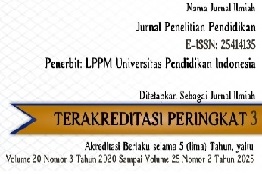Preferensi Gaya Belajar Perseptual Siswa Sekolah Menengah Pertama
Abstract
Penelitian ini dilakukan untuk mengetahui preferensi gaya atau tipe belajar siswa pada sekolah dasar menengah, dan untuk melihat apakah ada perbedaan antara preferensi gaya belajar siswa laki-laki dan perempuan. Sampel penelitian ini adalah 27 siswa siswa SMP, 12 siswa perempuan dan 15 siswa laki-laki. Penelitian ini adalah penelitian kuantitatif yang menggunakan Kuesioner Perceptual Learning oleh Reid (1987) sebagai instrumen. Hasil penelitian menunjukkan bahwa gaya belajar yang disukai siswa adalah gaya belajar kelompok, sedangkan gaya belajar yang paling tidak disukai adalah gaya belajar individu, disimpulkan bahwa murid laki dan perempuan memang berbeda secara unik dalam preferensi mereka pada gaya belajar.
Keywords
Full Text:
PDFReferences
Aries, E. (1976). Interaction Patterns and Themes of Male, Female, and Mixed Groups. Small Group Behavior, 7(1), 7–18. doi:10.1177/104649647600700102.
Atman, K. S. (1988). Research: Psychological type elements and goal accomplishment style: Implications for distance education. American Journal of Distance Education, 2(3), 36–44. doi:10.1080/08923648809526634.
Babich, A. M., Burdine, P., Albright, L., & Randol, P. I. (1976). Center for Information Teaching Experiences (CITE) Learning Styles Instrument. Wichita, KA: Murdoch Teachers Center.
Brown, H. Douglas. 2007. Principles of Language Learning and Teaching (5th Edition). White Plain: Pearson Education, Inc.
Claxton, C. S., & Ralston, Y. (1978). Learning styles: Their impact on teaching and administration. Washington, DC: American Association for Higher Education.
Dunn, R.S. and Dunn, K. (1992). Teaching Elementary Students Through Their Individual Learning Styles: Practical Approaches for Grades 3–6. Needham Heights, MA: Allyn and Bacon.
Ehrman, M., & Leaver, B. L. (2003). Cognitive styles in the service of language learning. System, 31(3), 393–415, doi: 10.1016/s0346-251x(03)00050-2.
Farzaneh, N. & Nejadansari, D. (2014). Students’ Attitude towards Using Cooperative Learning for Teaching Reading Comprehension. Academy Publisher Manufactured in Finland. Theory and Practice in Language Studies, Vol 4(2), pp. 287-292. https://pdfs.semanticscholar.org/883c/ae9e16828f48b6f57884d1de9e220e4a6ac1.pdf.
Fox, T. (1990). Gender Interest in Reading and Writing. Norwood, NJ: Ablex.
Gilakjani, A. P. (2012). Visual, Auditory, Kinaesthetic Learning Styles and Their Impacts on English Language Teaching. Journal of Studies in Education, 2(1), 104-113. doi:10.5296/jse.v2i1.1007.
Griffith, C. (Ed.). (2008). Lessons from Good Language Learners. Cambridge: Cambridge University Press. 324pp. ISBN 978-0-521-71814-1.
Hudson, L. (1966). Contrary imaginations. Harmondsworth: Penguin.
Kagan, J. (1965). Impulsive and reflective children: significance of conceptual tempo. In J.D. Krumboltz (ed.), Learning and the Educational Process. Chicago, IL: Rand McNally, pp. 133–161.
Karthigeyan, K., & Nirmala, K. (2013). Learning Style Preference of English Language Learners. Educationia Confab, 2(1), 134-140. https://pdfs.semanticscholar.org/606c/5610f3ff8c8e6ef7fcafc6a9bdbc25f6849a.pdf.
Kirby, J. (1988). Style, Strategy, and Skills in Reading. In R.R. Schmeck (ed.), Learning Strategies and Learning Styles. New York: Plenum, 229–274.
Kogan, N. (1971). Educational implications of cognitive styles. In G.S. Lesser (ed.), Psychology and Educational Practice. Glenview, IL: Scott, Foresman & Company, pp. 242–292.
Kogan, N., & Wallach, M. A. (1964). Risk-taking: A Study in Cognition and Personality. New York: Holt, Rinehart, and Winston.
Kothari, C. R. (2004). Research Methodology: Methods and Techniques (Second Revision Edition). New Age International Publishers.
Leet-Pellegrini, H. (1980). Conversational Dominance as a Function of Gender and Expertise. In Language: Social Psychological Perspectives, eds. H. Giles, W. Robinson & P.Smith. New York: Pergamon.
Lewenfeld, V. (1945). Tests for visual and haptical aptitudes. American Journal of Psychology, 58, 100–112.
Marcus, L. (1999). A Comparison of Selected Male and Female Students’ Learning Styles. New York: Oxford University Press.
Natsir, Y., Yusuf, Y. Q., & Huri, A. D. (2016). The Male and Female EFL Students’ Language Learning Styles. Proceedings of English Education International Conference, 1, 66-73.
Nel, C. (2008). Learning Style and Good Language Learners. In C. Griffith (ed), Lessons from Good Language Learners. (Cambridge Language Teaching Library). Cambridge: Cambridge University Press.
Obralic, N., & Akbarov, A. (2012). Students Preferences on Perceptual Learning Style. Acta Didactica Napocensia, 5(5), 31-42.
Oflaz, M., & Turunc, T. (2012). The Effect of Learning Styles on Group Work Activities. Procedia - Social and Behavioural Sciences, 46, 1333 – 1338.
Oxford, R. L. (1993). Style Analysis Survey (SAS). Tuscaloosa, AL: University of Alabama.
Pask, G. (1972). A fresh look at cognition and the individual. International Journal of Man-Machine Studies, 4, 211–216.
Peters A. M. (1977). Language learning strategies: does the whole equal the sum of the parts? Language, 53, 560–573.
Reid, J. (1987). The Learning Style Preferences of ESL Students. TESOL Quarterly, 21(1), 87-111.
Richardson, A. (1977). Verbalizer-visualizer: a cognitive style dimension. Journal of Mental Imagery, 1(1), 109–126.
Sadeghi, M. R. (2013). EFL male and female learning styles and multiple intelligences: A case of Iranian EFL university students. Iranian Journal of Research in English Language Teaching, 1(2), 33-46.
Schmeck, R. R. (1981). Improving learning by improving thinking. Educational Leadership, 38, 384.
Skehan, P. (1991). Individual Differences in Second Language Learning. Studies in Second Language Acquisition, 13, 275-298.
Tatarintseva, A. (2002). The Influence of the Gender Factor to the Learning Styles of Secondary Students in the Process of Language Learning. Kalbų Studijos. Studies About Languages, No. 2, pp. 63-68.
Torrance, E. P., & Rockenstein, Z. L. (1988). Styles of thinking and creativity. In R.R. Schmeck (ed.), Learning strategies and learning styles. New York: Plenum Press, 275–290.
Witkin, H., Lewis, H., Hertzman, M., Machover, K., Meissner, P., & Wapner, S. (1954). Personality Through Perception. New York: Harper.
DOI: https://doi.org/10.17509/jpp.v20i2.22123
Refbacks
- There are currently no refbacks.
Copyright (c) 2020 Jurnal Penelitian Pendidikan


